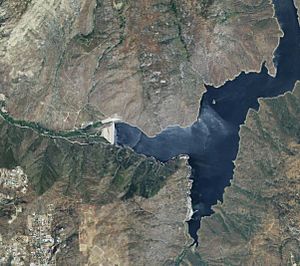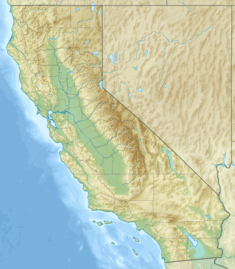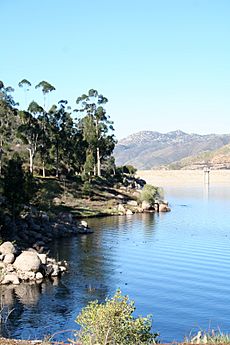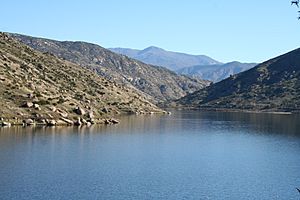El Capitan Dam facts for kids
Quick facts for kids El Capitan Dam |
|
|---|---|

Satellite view
|
|
|
Location of El Capitan Dam in California
|
|
| Country | United States |
| Location | Cleveland National Forest, San Diego County, California |
| Coordinates | 32°53′02″N 116°48′34″W / 32.88389°N 116.80944°W |
| Owner(s) | City of San Diego |
| Dam and spillways | |
| Type of dam | Embankment |
| Impounds | San Diego River |
| Height | 237 ft (72 m) |
| Length | 1,170 ft (360 m) |
| Reservoir | |
| Creates | El Capitan Reservoir |
| Total capacity | 112,800 acre⋅ft (139,100,000 m3) |
| Catchment area | 190 sq mi (490 km2) |
| Surface area | 1,536 acres (622 ha) |
El Capitan Dam is a large embankment dam built on the San Diego River in southern California. An embankment dam is a type of dam made mostly from compacted earth and rock. This dam creates the El Capitan Reservoir, which can hold about 112,800-acre-foot (139,100,000 m3) of water. Its main job is to provide water to the city of San Diego. It also helps control floods.
The dam is connected to San Diego's water system by the El Capitan Pipeline. This pipeline stretches about 30 miles (48 km) to the city. El Capitan Dam is the second largest water storage facility for San Diego. Only the San Vicente Dam holds more water.
Contents
Building the Dam: A Look Back
Early Ideas and Challenges
People first thought about building a dam on the San Diego River in the early 1900s. This was after several years of drought, when there wasn't enough rain. The city of San Diego hired an engineer named Hiram N. Savage to design the dam.
Savage suggested building the dam at Mission Gorge. This area had strong bedrock, which was perfect for a masonry dam (a dam built with stone or brick). It was also only 7 miles (11 km) from the city. However, a reservoir there would have flooded a large farming area in Mission Valley. This area is now downtown Santee. Also, a wide reservoir would lose a lot of water to evaporation.
The city of San Diego preferred a different spot, at El Capitan. This site was more than 30 miles (48 km) upstream. The good thing about El Capitan was that it would create a narrower, deeper reservoir. This meant less water would evaporate. But the El Capitan site had deeper bedrock. This would require building a more expensive embankment dam. It also needed a longer pipeline to carry water to the city. Savage didn't want to consider the El Capitan site, so the city fired him in 1923.
Native American communities living in the area were against the project because their land would be flooded. Some insisted the city give them new land before they moved important grave sites. In 1919, Congress passed the El Capitan Act. This act transferred the Native Americans' water rights and lands to the city of San Diego. In return, they would be resettled elsewhere and receive $361,420 from the city. This act later included protecting the entire watershed (the area of land that drains into the river) to keep the water clean.
Local water companies, like the Cuyamaca Flume Company, also opposed the dam. They worried it would reduce the amount of San Diego River water they could use. Legal battles went on for years. This made many San Diego taxpayers think about other reservoir locations.
Overcoming Obstacles
Construction of the dam was paid for by $4.5 million in revenue bonds in 1924. These are like loans that would be paid back from the dam's future earnings. Even with voter approval, the project didn't start until the 1930s. This was when San Diego finally won its legal fight for the necessary water rights.
Surprisingly, the city asked Savage again to design the El Capitan dam. He still thought it was a bad location and refused. In 1931, people voted on whether the dam should be built at El Capitan or Savage's preferred Mission Gorge. Mission Gorge lost by a small number of votes. Savage finally agreed to design the dam, which was the first of its kind he had ever built. He died of heart failure just six months after the dam was finished.
Construction on the dam began in December 1931. Workers used the hydraulic fill method, which involves pumping earth and water to build the dam. The main part of the dam was finished in 1934. The final cost was $5.8 million. This was the second dam built by the city in the San Diego River basin. The first was the Cuyamaca Dam in 1884. The El Capitan Pipeline, which carries water from the reservoir to the city, was also completed in 1934. The reservoir didn't fill completely until 1938. This happened after big storms caused severe flooding in Southern California.
How El Capitan Dam Works
Dam Structure and Water Flow
El Capitan Dam is an embankment dam made of rock with a special clay core inside. This clay core stops water from leaking through. The dam is located in a narrow granite canyon. It sits just below where Conejos Creek joins the San Diego River.
The dam is 237 feet (72 m) tall from its base and 219 feet (67 m) tall from the riverbed. It is 1,170 feet (360 m) long at the top and 26 feet (7.9 m) wide at the top. The entire dam contains about 2,679,680 cubic yards (2,048,760 m3) of material.
The spillway is a concrete channel on the north side of the dam. It has no gates. Water flows over it automatically when the reservoir gets too full. The spillway can handle a lot of water, up to 170,700 cubic feet per second (4,830 m3/s).
Water is released into the El Capitan Pipeline through a control tower. This tower has six 30-inch (760 mm) valves. These valves allow water to be taken from different depths in the reservoir. This helps control the water's temperature and turbidity (how cloudy or clear the water is). The pipeline can carry 61 million gallons (about 1,727,000 m3) of water per day.
The Reservoir: San Diego's Water Storage
When full, El Capitan Reservoir is about 8 miles (13 km) long. The water level reaches about 750 feet (230 m) high. The reservoir's surface area is 1,562 acres (632 ha), and it can hold 112,807 acre-feet (139,145,000 m3) of water. It is the largest of San Diego's local reservoirs that collect rainwater. (The San Vicente Reservoir is bigger, but it mainly stores water brought in from the Colorado River).
El Capitan Reservoir rarely fills to its maximum capacity. This is because it's so large compared to the average amount of water that flows into it from the surrounding land. On average, the reservoir holds about 48,474 acre-feet (59,792,000 m3) in April and 34,461 acre-feet (42,507,000 m3) in November. The water levels can change a lot. This is because the region can have very big floods or droughts that last for many years.
The average rainfall at El Capitan Dam is 15.9 inches (400 mm) per year. This can range from 12 inches (300 mm) in lower areas to 33 inches (840 mm) in the highest mountains. The reservoir receives about 31,666 acre-feet (39,059,000 m3) of water each year on average. During winter and early spring, the reservoir is usually kept at no more than two-thirds full. This helps prevent uncontrolled spills. However, because the dam is high up in the watershed, it has limited ability to control flooding further down the San Diego River.




